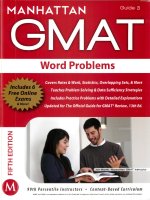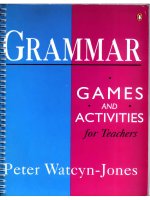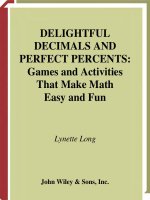Wacky word problems games and activities that make math easy and fun
Bạn đang xem bản rút gọn của tài liệu. Xem và tải ngay bản đầy đủ của tài liệu tại đây (6.45 MB, 131 trang )
WACKY W ORD
P ROBLEMS
Games and Activities
That Make Math Easy and Fun
Lynette Long
John Wiley & Sons, Inc.
Magical Math
ffirs.qxd 10/25/04 9:55 AM Page iii
ffirs.qxd 10/25/04 9:55 AM Page iii
WACKY W ORD
P ROBLEMS
ffirs.qxd 10/25/04 9:55 AM Page i
Also in the Magical Math series
Dazzling Division
Delightful Decimals and Perfect Percents
Fabulous Fractions
Great Graphs
Groovy Geometry
Marvelous Multiplication
Measurement Mania
ffirs.qxd 10/25/04 9:55 AM Page ii
WACKY W ORD
P ROBLEMS
Games and Activities
That Make Math Easy and Fun
Lynette Long
John Wiley & Sons, Inc.
Magical Math
ffirs.qxd 10/25/04 9:55 AM Page iii
This book is printed on acid-free paper.
Copyright 2005 by Lynette Long. All rights reserved
Illustrations copyright 2005 by Tina Cash-Walsh. All rights reserved
Published by John Wiley & Sons, Inc., Hoboken, New Jersey
Published simultaneously in Canada
Design and composition by Navta Associates, Inc.
No part of this publication may be reproduced, stored in a retrieval system, or transmitted in any form or by
any means, electronic, mechanical, photocopying, recording, scanning, or otherwise, except as permitted
under Section 107 or 108 of the 1976 United States Copyright Act, without either the prior written permission
of the Publisher, or authorization through payment of the appropriate per-copy fee to the Copyright Clearance
Center, 222 Rosewood Drive, Danvers, MA 01923, (978) 750-8400, fax (978) 646-8600, or on the web at
www.copyright.com. Requests to the Publisher for permission should be addressed to the Permissions Depart-
ment, John Wiley & Sons, Inc., 111 River Street, Hoboken, NJ 07030, (201) 748-6011, fax (201) 748-6008.
The publisher and the author have made every reasonable effort to ensure that the experiments and activities
in this book are safe when conducted as instructed but assume no responsibility for any damage caused or sus-
tained while performing the experiments or activities in the book. Parents, guardians, and/or teachers should
supervise young readers who undertake the experiments and activities in this book.
For general information about our other products and services, please contact our Customer Care Department
within the United States at (800) 762-2974, outside the United States at (317) 572-3993 or fax (317)
572-4002.
Wiley also publishes its books in a variety of electronic formats. Some content that appears in print may
not be available in electronic books. For more information about Wiley products, visit our Web site at
www.wiley.com.
Library of Congress Cataloging-in-Publication Data
Long, Lynette.
Wacky word problems : games and activities that make math easy and fun / Lynette Long.
p. cm. —(Magical math)
Includes index.
ISBN 0-471-21061-7 (pbk. : alk. paper)
1. Mathematical recreations. I. Title.
QA95.L825 2005
793.74—dc22
2004014921
Printed in the United States of America
10987654321
ffirs.qxd 10/25/04 9:55 AM Page iv
v
Contents
I. The Magic of Word Problems 1
II. Computation 3
1 Word Clues 5
2 All about Me! 9
3 All Four 11
4 Two Steppers 13
III. Measurement 15
5 Conversion Cards 17
6 Crazy Contests 21
7 Vital Statistics 24
8 Up and Down 27
9 Quart Power 30
10 Measurement Jeopardy 32
IV. Counting and Logic Problems 35
11 Block It Out 37
12 Penny Math 40
13 Venn Diagrams 42
14 Who Is Older? 44
V. Percentage Problems 47
15 Percentage War 49
16 Tipping Wheel 52
17 Sales Galore 55
18 How Much? 58
19 Simple Interest 60
ftoc.qxd 10/25/04 9:59 AM Page v
vi
VI. Distance Problems 65
20 How Fast? 67
21 How Far? 69
22 How Slow? 72
23 How Long? 74
24 Ten-Second Sprints 77
25 Racing Cars 79
VII. Algebra 81
26 Crazy Sentences 83
27 Just X 85
28 Shoebox Math 87
29 X and Y 89
30 Guess and Check 92
31 Envelope Stuffing 94
VIII. Geometry and Graphing 97
32 Graph Paper Geometry 99
33 Shape Illusions 101
34 Tricky Triangles 10 3
35 True Circles 105
36 Switch 107
IX. Wrap It Up 109
37 Mystery Word Problems 111
38 Word Problem Charades 11 2
39 Answers, Answers, and More Answers 11 4
40 Formulas . . . Formulas . . . Formulas 11 6
Word Problem 118
Master Certificate
Index 119
ftoc.qxd 10/25/04 9:59 AM Page vi
1
I
T HE M AGIC OF
W ORD P ROBLEMS
W
hen you’re not in class, how often do you ask yourself, “What is 821 +
53 + 444?” or “What is 16 × 4?” or “What is 32 divided by 8?” Proba-
bly not very often, unless you’re reading your homework out loud. So why
study math? Well, although you may not realize it, you answer these kinds of
questions in word problems all the time.
c01.qxd 10/25/04 10:01 AM Page 1
2
For example, your parents are driving you to your favorite amusement
park. You sit in the back seat, wondering, How long until we get there? If your
parents tell you the distance to the park and how fast the car is going, can
you figure it out? This is a word problem!
You stop at a restaurant after school. You look at the money in your
pocket and wonder, Do I have enough to get a meal and dessert? You know the
prices from the menu. Can you figure it out? Another word problem!
You get your spelling test back. Your score is 17 out of 21. You ask your-
self, What percentage did I get correct? You know you’ll get a B or better if you
got more than 80 percent right. Can you figure it out? Yep, that’s a word
problem.
You go clothes shopping, and your favorite store has a sale on all jeans—
30 percent off. You wonder, How much will those jeans really cost me? You
know the original price of the jeans. Can you figure out the sale price?
Another word problem.
You will be surprised at how many word problems you try to solve every
day—problems about time, distance, money, percentages, and measurement,
to name a few. In fact, word problems can be about anything, as long as they
are written as a story and pose a mathematical problem.
Some students think word problems are difficult, because they pose a
problem but don’t tell you how to solve it. Word problems don’t tell you to
add these three numbers or multiply these two numbers. They just ask a
question and give you the facts you need to solve it. The trick is to know
what to do with those facts. That’s what you’re about to find out!
In this book you’ll practice until you become a word problem master.
You’ll learn what to do when solving the most common types of word prob-
lems. It’s not as hard as you think. There are clues to look for, rules to learn,
and a few formulas to memorize, but after that, the word problems you
encounter every day will seem like a breeze.
Why not get started? A lot of fun activities await you.
c01.qxd 10/25/04 10:01 AM Page 2
3
II
C OMPUTATION
T
he word problems in this section use simple
computation. To solve these
problems, you will add, subtract,
multiply, or divide. Learning
how to solve these basic word
problems is the first step in
becoming a word problem
master.
In this section you will
play a card game as you
learn to identify word cues,
make up word problems
about yourself, use the
phone book to play a word
problem game, and express
your creativity by creating
word problems to match math-
ematical expressions. Word prob-
lems are not just about math;
they are also about words
and the special way words
are used and interpreted in
word problems.
c02.qxd 10/25/04 10:04 AM Page 3
c02.qxd 10/25/04 10:04 AM Page 4
Game Preparation
Write each of the following words on a different index card. Each of these
words is commonly found in word problems, and every word provides a
clue about how to solve the word problem. Some words mean you should
use addition, some mean that you use subtraction, some mean that you use
multiplication, and some mean that you use division to solve the word
problem.
M ATERIALS
5
1
Word Clues
pencil
index cards
sum
perimeter
total
all
altogether
difference
less
fewer
change
minus
times
area
product
percent
of
split
divide
average
share
part
Learn what key words to look for
in word problems while you
play a card game.
c02.qxd 10/25/04 10:04 AM Page 5
Game Rules
1. Deal each player three cards. Place the rest of the cards face down in the
center of the table.
2. Players take turns picking a single card from the top of the pile and dis-
carding a single card. The object of the game is to collect three cards that
all mean addition, subtraction, multiplication, or division.
3. The first player to collect three cards that mean the same mathematical
operation wins the round. The first player to win three rounds wins the
game.
6
Here’s how to group the cards according to operation:
Addition Subtraction Multiplication Division
Sum Difference Times Split
Perimeter Less Area Divide
Total Fewer Product Average
All Change Percent Share
Altogether Minus Of Part
c02.qxd 10/25/04 10:04 AM Page 6
7
R
ead each of the following word problems and decide whether you have
to add, subtract, multiply, or divide. Circle the correct answer. Under-
line the word that gave you the clue.
[
If you ate 174 earwax flavor jelly beans and 63 dirt flavor jelly beans,
how many more earwax jelly beans than dirt jelly beans did you eat?
To solve this problem, do you add, subtract, multiply, or divide?
[ If you scored 8 goals in each of 10 foosball games, how many
goals did you score altogether? To solve this problem, do you add,
subtract, multiply, or divide?
[ If 4 frisky ferrets destroyed 3 red
balls and 4 green balls, how
many balls did they destroy
altogether? To solve this
problem, do you add, sub-
tract, multiply, or divide?
[ If you divided a 12-slice pepperoni, pineapple, and pickle pizza
equally among 4 hungry students, how many slices of pizza would
each person get? To solve this problem, do you add, subtract,
multiply, or divide?
(Answers: Subtract; Multiply; Add; Divide)
c02.qxd 10/25/04 10:04 AM Page 7
8
If each of
five
dinner, how ma
ny
h
at is the difference between
3+2)x6and3
+
(
2 x 6)?
$6.
40
How many
T
o
fi
n
d
ou
t
a 20% tip
w
Money Earned
= (price paid per envelope)
wha
t
E
ach player rolls a single die. The number rolled represents an
arithmetic operation.
1 = addition
2 = subtraction
3 = multiplication
4 = division
5 = choice
6 = roll again
Each player has 5 minutes to write down as many words or
phrases as possible that are used in word problems to represent the
word that was rolled. For example, if you rolled “1,” which represents
“addition,” you could write “altogether” on your list. The player who
can think of the most words or phrases for his or her operation wins
the game.
c02.qxd 10/25/04 10:04 AM Page 8
Learn to solve simple word problems by working backward
from answers to some questions about you.
Procedure
1. How old are you? Take half of your age. Now subtract 2 from your
answer. What’s your answer?
2. Write the following word problem on an index card:
“If you take half my age and subtract 2 from the answer, you get
(answer here). How old am I?”
3. Write your age on the other side of the card.
2
All about Me!
M ATERIALS
9
paper
pencil
index cards
tape
poster board
c02.qxd 10/25/04 10:04 AM Page 9
4. What is the number of the month in which you were born? January is 1,
February is 2, and so on. Double the number of the month in which you
were born and subtract 2. What number did you get?
5. Write the following word problem on an index card:
“If you take the number that represents the month in which I was
born and double it and then subtract 2, you get (answer here).
What month was I born in?”
6. Put the name of the month in which you were born on the back of the
index card.
7. Make up similar questions and answers for the following facts about
you. Write each question on the front of an index card. Write the answer
on the back.
a. How tall am I in inches?
b. What day of the month was I born?
c. What size shoes do I wear?
d. What is my zip code?
e. How many students are in my class?
f. What is the number of my classroom?
8. Now tape all the index cards on a sheet of poster board. Put the tape
only at the top of the card so that you can lift it up. The questions
should be face up so that if you lift up the card, the answer is on the
other side.
9. Put a title at the top of the poster board.
10. Share your poster board with your family and friends. Can they figure
out the facts about you?
10
c02.qxd 10/25/04 10:04 AM Page 10
Play this game using
advertisements from a
phone book to
design word
problems using
four different
operations.
Game Rules
1. One player rolls all three dice. The numbers on the dice are arranged to
form different numbers.
If 2, 3, and 6 are rolled, a list is made of the possible page numbers
that can be formed by these three numbers.
236, 263, 326, 362, 623, 632
3
All Four
M ATERIALS
3 dice
pencil
paper
phone book with
advertisements
2 players
11
EXAMPLE
c02.qxd 10/25/04 10:04 AM Page 11
2. Players look at these page numbers in the phone book, and each player
picks one company’s advertisement. (Note: Players cannot pick the same
advertisement.)
3. Each player writes four word problems about the items described in the
advertisement. Each problem should be based on one of the four opera-
tions: addition, subtraction, multiplication, or division.
You find this advertisement in a phone book:
Mike’s Boathouse
On the Banks of the Historic Potomac River
Rentals of Kayaks, Canoes, and Rowboats
Hourly/Daily Rates
Boat Rental Costs
Kayak—$6.50 per hour
Canoe—$4 per hour
Rowboat—$7 per hour
You then make up the following questions:
Which costs more to rent per hour, a kayak or a canoe? How much
more? (subtraction)
How much would it cost to rent a rowboat for 4 hours?
(multiplication)
How much would it cost to rent one rowboat, one canoe, and one
kayak for 1 hour? (addition)
If it costs $10 to rent a canoe for half of a day, and a half-day is 4
hours, how much does it cost to rent the canoe per hour? (division)
4. Players then exchange the problems they’ve made up and solve each
other’s problems.
12
(Answers: Kayak, $2.50 more; $28; $17.50; $2.50)
EXAMPLE
c02.qxd 10/25/04 10:04 AM Page 12
Play this game to construct
word problems that take two
steps to solve.
Procedure
1. Each player rolls both dice. The numbers on the dice represent different
operations.
1 = add
2 = subtract
3 = multiply
4 = divide
5 = choice
6 = roll again
2. Each player writes a number sentence on the index card, using the two
operations rolled and whatever numbers he or she chooses.
For example, if “add” and “multiply” are rolled, the player might write,
(3 + 2) × 6 or 1 + (5 × 7)
4
Two Steppers
M ATERIALS
2 dice
2 pencils
index cards
tape
2 players
13
c02.qxd 10/25/04 10:04 AM Page 13
3.
Players exchange problems, and both players write word problems that
match the expressions. For example, John gave 3 red lifesavers and 2 yellow
lifesavers to each of 6 friends. Or Georgette had 1 white bead and 5 beads
of each of 7 different colors. How many beads did she have altogether?
4. Players exchange problems again and solve them.
14
I
f 5 children each caught 3 stink bugs before dinner and 6 slugs after
dinner, how many critters did the children catch altogether?
five
children ca
ught
ny
bu
gs d
4
% discount
w
h
W
hat is the difference between
(3 + 2) × 6 and 3 + (2 × 6)?
(Answer: 45)
c02.qxd 10/25/04 10:04 AM Page 14
15
III
M EASUREMENT
M
easurement involves calculating distance, weight, volume, and time.
Measurement word problems often ask you to convert from one meas-
urement to another. What makes measurement complicated is that in the
United States, both metric and English units are used. Not only do you have
c03.qxd 10/25/04 10:07 AM Page 15
to learn to convert between the different English units (for example, from
pounds to ounces and vice versa), but you also must learn to convert
between English and metric units (for example, between miles and kilome-
ters). If that isn’t enough, you have to learn to convert between different
metric measurements; for example, how do you change from grams to
kilograms?
In this section, you’ll make conversion cards that will help you on your
metric journey. You’ll also enter into crazy physical contests with friends,
research an African animal, make a metric bookmark, learn a dozen ways to
make a quart, and play Measurement Jeopardy.
16
c03.qxd 10/25/04 10:07 AM Page 16









